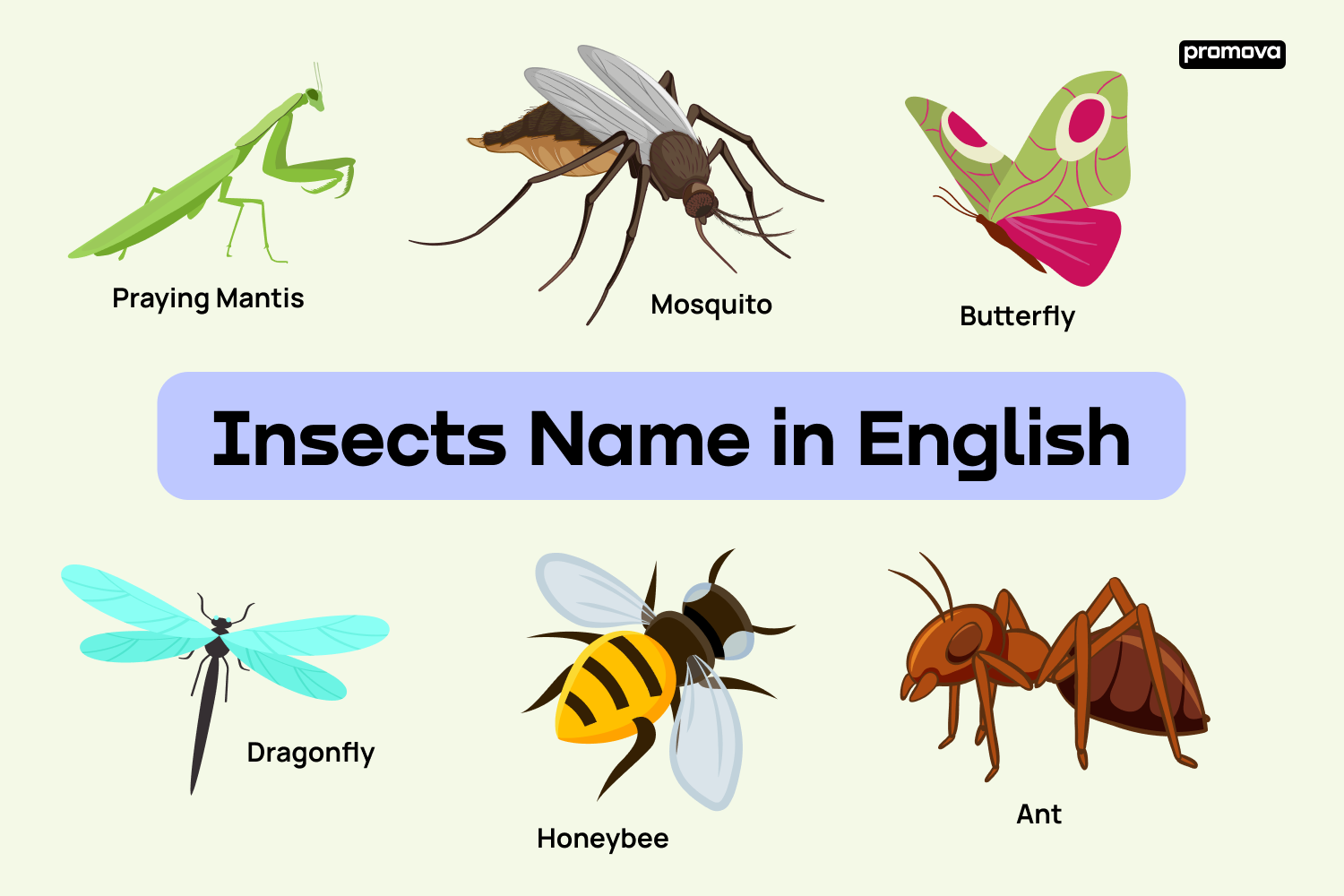Vocabulary of Insects Names
Contents
In the vast world of nature, insects play a pivotal role in maintaining ecological balance. For language learners, understanding and identifying these insects can be both educational and fascinating. This guide provides a comprehensive list of insects with their meanings, aiming to enhance your vocabulary in a delightful way.

Common Insects Names
When you first start studying insects’ names in English, you might come across some very common names. These are insects that you'll likely encounter in your daily life, especially during warmer seasons.
- Ant: a small insect that lives in a colony, known for its strong work ethic.
- Bee: a flying insect that produces honey and can sting.
- Butterfly: a beautiful, often colorful, insect with large wings.
- Cockroach: a resilient insect often found in homes, considered a pest.
- Fly: a small-winged insect that is often seen buzzing around food.
- Ladybug: a small round insect with a red shell and black spots; considered beneficial in gardens.
- Mosquito: a small flying insect that sucks blood and can transmit diseases.
- Grasshopper: a jumping insect that can produce a chirping sound; feeds on plants.
- Beetle: a group of insects characterized by a hard exoskeleton and wings.
- Termite: a small insect that feeds on wood, often causing damage to structures.
- Wasp: a flying insect that can sting, often building paper-like nests.
- Gnat: a small flying insect that can be a nuisance but is mostly harmless.
Understanding these common bugs’ names is essential for daily conversation and cultural insights. Their prevalence in various settings means you're likely to encounter them or references to them often.
Beneficial Insects
Some insects provide immense benefits to our environment, gardens, and farms. Familiarize yourself with these allies of the natural world.
- Ladybug: helpful in gardens; eats pests like aphids.
- Earthworm: vital for soil aeration and decomposition.
- Praying mantis: a green insect that consumes other pests.
- Honeybee: crucial for pollination.
- Dragonfly: preys on mosquitoes and other pests.
- Lacewing: consumes aphids, mites, and other pests.
- Bumblebee: another pollinator, larger and furrier than the honeybee.
- Parasitic wasp: lays its eggs inside pests, controlling their population.
- Spined soldier bug: preys on harmful insects like caterpillars and beetle larvae.
- Braconid wasp: helps control pest populations by parasitizing them.
- Ground beetle: nocturnal predator that eats slugs, snails, and other pests.
These insects play a critical role in maintaining ecological balance. By recognizing and appreciating their contributions, you can cultivate a more eco-friendly environment.
9
Nighttime Insects
Night brings out a unique array of insects, each with its captivating behaviors and adaptations for life in the dark.
- Firefly: produces light in its abdomen.
- Moth: attracted to lights at night.
- Cricket: known for its chirping sound.
- Bedbug: feeds on human blood, found in mattresses.
- Nightcrawler: a type of earthworm active during the night, often used for fishing.
- Kissing bug: feeds on the blood of mammals and can transmit Chagas disease.
- Silverfish: a wingless insect often found in homes; feeds on carbohydrates like paper.
- Cicada: known for its loud song, most active in the evening.
- Katydid: related to crickets and grasshoppers, produces a distinct sound at night.
The nighttime insects’ names world is rich and varied. Learning about these creatures deepens your understanding of nature's cycles and the diverse life that thrives under the cover of darkness.
Aquatic Insects
The realm of water bodies, be it freshwater or brackish, houses an array of specialized insects. These creatures have adapted to life in or around water, playing crucial roles in aquatic ecosystems.
- Water strider: an insect that skims across the surface of the water using surface tension.
- Caddisfly: known for its larvae that build protective cases from materials like twigs or pebbles.
- Dragonfly nymph: the aquatic juvenile stage of dragonflies; a fierce underwater predator.
- Damselfly nymph: similar to dragonfly nymphs but slender; also an underwater predator.
- Water beetle: a broad category of beetles that live and dive in water.
- Whirligig beetle: known for its circular motion on water surfaces.
- Mayfly: has a brief adult life; its nymph stage is aquatic and essential for freshwater health.
- Mosquito larva: the water-dwelling stage of mosquitoes before they become flying adults.
- Backswimmer: swims upside down in water and preys on other insects.
- Water boatman: uses long legs like oars to swim and feeds on aquatic plants and algae.
The world of aquatic bugs’ names is fascinating. By understanding their life cycles and behavior, you can gain insights into the health and dynamics of freshwater ecosystems.
Desert Insects
Deserts, though seemingly barren, teem with life. Many insects have evolved specific adaptations to survive the extreme conditions of these arid landscapes.
- Desert locust: known for its swarming behavior; can eat its weight in plants daily.
- Desert ant: uses the sun to navigate and can survive extremely hot temperatures.
- Jerusalem cricket: a large, flightless insect that feeds on organic matter.
- Painted grasshopper: brightly colored and often found in desert regions.
- Desert termite: vital for desert ecology; breaks down tough plant matter.
- Darkling beetle: survives by collecting condensed water on its body from morning fogs.
- Velvet ant: actually a wingless wasp; known for its painful sting.
- Pallid-winged grasshopper: often swarms in desert areas after rain.
- Desert firetail: a type of damselfly adapted to the desert environment.
Desert insects showcase the remarkable adaptability of life. Their resilience and unique behaviors make them essential components of their arid habitats, contributing significantly to the desert ecosystem.
Conclusion
Insects, with their myriad forms and behaviors, offer language learners a chance to expand their vocabulary in an engaging manner. By familiarizing yourself with these insects and their roles in nature, you not only enhance your language skills but also gain a deeper appreciation of the world around you.



Comments